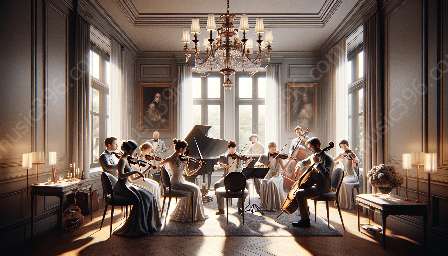Classical music is a rich tapestry of sound, brought to life by an array of instruments that have been refined over centuries. In this exploration of instruments in classical music, we will delve into the string, woodwind, brass, and percussion instruments, each with its own unique characteristics and significance in classical compositions.
String Instruments
Violin: The violin is hailed as the prince of instruments in classical music and a prominent member of the string family. Its versatility and expressive capabilities make it a cornerstone of orchestral music and chamber ensembles.
Viola: Slightly larger than the violin with a deeper tone, the viola often provides the middle voice in string quartets and orchestral arrangements, adding depth and richness to the overall sound.
Cello: Known for its warm, sonorous tones, the cello lends a profound and emotive quality to classical compositions, often featured in solo performances and as part of the symphony orchestra.
Double Bass: With its commanding presence and deep, resonant sound, the double bass anchors the orchestral bassline and provides a solid foundation for the ensemble.
Harp: The ethereal and enchanting harp adds a celestial quality to classical music, often employed in orchestral works and solo recitals.
Woodwind Instruments
Flute: The flute's lilting and agile melodies grace classical compositions with its airy and radiant sound, serving as a versatile solo and ensemble instrument.
Clarinet: Known for its expressive range and velvety timbre, the clarinet brings lyrical beauty and emotional depth to classical music, often featured in chamber ensembles and orchestral settings.
Oboe: Renowned for its haunting and poignant sound, the oboe commands attention in classical music, adding a distinctive voice to ensembles and orchestras.
Bassoon: With its rich and noble timbre, the bassoon lends gravitas and depth to classical compositions, anchoring the woodwind section with its resonant sound.
French Horn: Revered for its noble and majestic sound, the French horn enriches classical music with its regal presence, often featured in orchestral, chamber, and solo performances.
Brass Instruments
Trumpet: The vibrant and triumphant trumpet commands attention with its bold fanfares and expressive melodies, playing a prominent role in classical orchestral and solo repertoire.
Trombone: Known for its robust and resonant sound, the trombone adds depth and power to classical music, often featured in orchestras, brass ensembles, and solo performances.
Tuba: The commanding and noble tuba provides the foundational bass voice in classical orchestral and brass ensemble music, enriching compositions with its sonorous presence.
Percussion Instruments
Timpani: The timpani's thunderous and majestic sound punctuates classical compositions with dramatic impact, adding rhythmic drive and grandeur to orchestral performances.
Snare Drum: With its crisp and precise rhythms, the snare drum contributes precision and energy to classical music, often featured in orchestral, band, and percussion ensemble settings.
Cymbals: The shimmering and sonorous cymbals bring a touch of brilliance and excitement to classical compositions, accentuating climactic moments and adding splendor to orchestral performances.
Marimba: The warm and resonant tones of the marimba infuse classical music with melodic richness and rhythmic vibrancy, offering a compelling presence in contemporary classical works and percussion ensembles.
These instruments, spanning the realms of string, woodwind, brass, and percussion, form the cornerstone of classical music, enriching compositions with their unique timbres, expressive capabilities, and centuries-old traditions. Whether performing as soloists, in ensembles, or as part of a grand symphony orchestra, each instrument contributes to the timeless allure and emotional depth of classical music, captivating audiences with its artistry and resonating power.
Topic
The Flute: A Diverse Instrument in Classical Repertoire
View details
The French Horn: A Regal Presence in Classical Ensembles
View details
The Trombone: A Key Player in Orchestral Settings
View details
Tuba Through the Centuries: History and Influence
View details
The Artistry of the Harp in Classical Compositions
View details
Exploring Keyboard Instruments in Classical Repertoire
View details
Pipe Organ: Majesty and Grandeur in Classical Music
View details
The Harpsichord: Baroque Elegance in Keyboard Music
View details
Percussion: Rhythm and Texture in Classical Ensembles
View details
Crafting Sounds: Classical Guitar Strings and Tones
View details
Instrumental Composition and Arrangement in Classical Music
View details
Emotional Impact of Classical Music Instruments in Compositions
View details
Performance Styles and Interpretations Across Instruments
View details
Technological Advancements in Classical Instrument Design
View details
Preservation and Restoration of Antique Classical Instruments
View details
Transformation of Study and Performance of Classical Instruments
View details
Career Path of a Classical Music Instrument Performer
View details
Cultural and Historical Significance of Classical Music Instruments
View details
Ethical Considerations in Classical Instrument Construction
View details
Enhancing Musical Education through Understanding Classical Instruments
View details
Questions
What is a violin and how does it produce sound?
View details
What are the essential techniques for playing the cello?
View details
What role does the viola play in a classical music ensemble?
View details
How does a double bass contribute to the symphony orchestra?
View details
What are the differences between a modern and a historical flute?
View details
How did the clarinet become a prominent instrument in classical music?
View details
What are the main features of the oboe, and how is it used in orchestral settings?
View details
What distinguishes the bassoon from other woodwind instruments?
View details
How has the French horn's role in classical music evolved?
View details
What are the unique characteristics of the trumpet as a classical music instrument?
View details
How does the trombone contribute to the brass section of a symphony orchestra?
View details
What are the origins and development of the tuba in classical music?
View details
How has the harp been utilized in classical music compositions?
View details
What are the different types of keyboard instruments in classical music?
View details
What distinguishes a piano from other keyboard instruments?
View details
How has the pipe organ been used in traditional and contemporary classical music?
View details
What are the essential techniques for playing the harpsichord?
View details
What are the characteristics of percussion instruments in classical music?
View details
How is the timpani used in orchestral and chamber music compositions?
View details
What are the different types of strings used on classical guitars and their tonal qualities?
View details
How does the classical guitar differ from other types of guitars?
View details
What are the key elements of classical music composition and arrangement for instruments?
View details
How do classical music instruments contribute to the overall emotional impact of a composition?
View details
What are the different styles of classical music performance and interpretation across various instruments?
View details
How has technology influenced the design and sound of classical music instruments?
View details
What are the challenges of preserving and restoring antique classical music instruments?
View details
What role do classical music instruments play in contemporary music genres and compositions?
View details
How has the study and performance of classical music instruments changed over the centuries?
View details
What skills and qualities are necessary for a career as a classical music instrument performer?
View details
How do classical music instruments contribute to the cultural and historical significance of classical music?
View details
What are the ethical considerations of using rare or endangered materials in classical music instrument construction?
View details
How does the understanding and appreciation of classical music instruments enhance musical literacy and education?
View details

































